Tibetan Buddhism
| Part of a series on |
| Tibetan Buddhism |
|---|
 |
|
|
Practices and attainment |
|
Institutional roles |
|
History and overview |
|
|
| Part of a series on |
| Vajrayana Buddhism |
|---|
 |
|
Traditions Historical traditions:
New branches:
|
|
History |
|
Pursuit |
|
Practices |
|
Festivals |
|
Ordination and transmission |
|
|
| Part of a series on |
| Mahāyāna Buddhism |
|---|
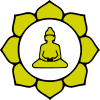 |
|
Transmission |
|
Teachings |
|
Mahāyāna schools |
|
|
| Part of a series on |
| Buddhism |
|---|
 |
|
Tibetan Buddhism is the form of Buddhist doctrine and institutions named after the lands of Tibet, but also found in the regions surrounding the Himalayas and much of Central Asia. It derives from the latest stages of Indian Buddhism and preserves "the Tantric status quo of eighth-century India."[1] It has been spread outside of Tibet, especially due to the Mongol power of the Yuan dynasty (1271–1368), founded by Kublai Khan, that also ruled China.
Tibetan Buddhism applies Tantric practices, especially deity yoga, and aspires to Buddhahood or the rainbow body.[2] Tibetan Buddhism in Tibet has four major schools, namely Nyingma, Kagyu, Sakya and Gelug (developed out of Sakya). The Jonang is a smaller school, and the Rimé movement is an eclectic movement involving the Sakya, Kagyu and Nyingma schools. Among the prominent proponents of Tibetan Buddhism are the Dalai Lama and Panchen Lama, the leaders of Gelug school in Tibet.
Doctrine
Buddhahood and Bodhisattvas
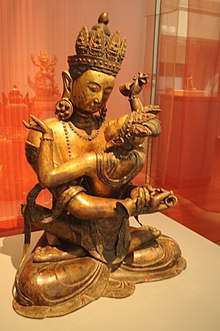
Tibetan Buddhism comprises the teachings of the three vehicles of Buddhism: the Foundational Vehicle, Mahāyāna, and Vajrayāna. The Mahāyāna goal of spiritual development is to achieve the enlightenment of buddhahood in order to most efficiently help all other sentient beings attain this state.[3] The motivation in it is the bodhicitta mind of enlightenment — an altruistic intention to become enlightened for the sake of all sentient beings.[4] Bodhisattvas are revered beings who have conceived the will and vow to dedicate their lives with bodhicitta for the sake of all beings. Widely revered Bodhisattvas in Tibetan Buddhism include Avalokiteshvara, Manjushri, Vajrapani, and Tara.
Buddhahood is defined as a state free of the obstructions to liberation as well as those to omniscience.[5] When one is freed from all mental obscurations,[6] one is said to attain a state of continuous bliss mixed with a simultaneous cognition of emptiness,[7] the true nature of reality.[8] In this state, all limitations on one's ability to help other living beings are removed.[9] Tibetan Buddhism claims to teach methods for achieving Buddhahood more quickly (known as the Vajrayāna path).[10]
It is said that there are countless beings who have attained buddhahood.[11] Buddhas spontaneously, naturally and continuously perform activities to benefit all sentient beings.[12] However it is believed that one's karma could limit the ability of the Buddhas to help them. Thus, although Buddhas possess no limitation from their side on their ability to help others, sentient beings continue to experience suffering as a result of the limitations of their own former negative actions.[13]
Lamrim
Lamrim (Tibetan: "stages of the path") is a Tibetan Buddhist textual form for presenting the stages in the complete path to liberation as taught by Buddha. In Tibetan Buddhist history there have been many different versions of lamrim, presented by different teachers of the Nyingma, Kagyu and Gelug schools.[14] However, all versions of the lamrim are elaborations of Atiśa's 11th-century root text A Lamp for the Path to Enlightenment (Bodhipathapradīpa).[15]
Atisha's lamrim system generally divides practitioners into those of lesser, middling and superior scopes or attitudes:
- The lesser person is to focus on the preciousness of human birth as well as contemplation of death and impermanence.
- The middling person is taught to contemplate karma, dukkha (suffering) and the benefits of liberation and refuge.
- The superior scope is said to encompass the four Brahmaviharas, the bodhisattva vow, the six paramitas as well as Tantric practices.[16]
Although lamrim texts cover much the same subject areas, subjects within them may be arranged in different ways and with different emphasis depending on the school and tradition it belongs to. Gampopa and Tsongkhapa expanded the short root-text of Atiśa into an extensive system to understand the entire Buddhist philosophy. In this way, subjects like karma, rebirth, Buddhist cosmology and the practice of meditation are gradually explained in logical order.
The Tantric view
Being a form of Vajrayana (Vajra vehicle) or Buddhist Tantra, Tibetan Buddhist doctrine also differs from non-Tantric forms of Buddhism in that it affirms the views espoused in the texts known as the Buddhist Tantras (dating from around the 7th century CE onwards).[17] Tantra (Tibetan: rgyud) generally refers to forms of religious practice which emphasize the use of unique visualizations, ideas, symbols and rituals for inner transformation.[18] The Vajrayana is seen by its adherents as the fastest and most powerful vehicle for enlightenment because it contains many special techniques and because it takes the effect (Buddhahood itself, or Buddha nature) as the path (and hence is sometimes known as the "effect vehicle").[19]
These texts also generally affirm the use of sense pleasures in Tantric ritual as a path to enlightenment, as opposed to non-Tantric Buddhism which affirms that one must renounce all sense pleasures.[20] These practices are based on the theory of transformation which states that negative or sensual mental factors and physical actions can be cultivated and transformed in a ritual setting, the Hevajra tantra states:
Those things by which evil men are bound, others turn into means and gain thereby release from the bonds of existence. By passion the world is bound, by passion too it is released, but by heretical Buddhists this practice of reversals is not known.[21]
Another element of the Tantras is their use of transgressive practices, such as drinking alcohol or sexual yoga. While in many cases these transgressions were interpreted only symbolically, in other cases they are practiced literally.[22]
Reincarnated lamas
Significant genuine innovations in Tibetan Buddhism have been few.[23] Although the system of incarnate lamas[note 1] is popularly held to be an innovation, it is disputable that this is a distinctly Tibetan development. Two centuries before Buddhism was introduced to Tibet, in the fifth century CE, the Abhidharma teacher Buddhaghoṣa was declared by Sri Lankan elders to be a reincarnation of the bodhisattva Maitreya.[24]
Texts and study
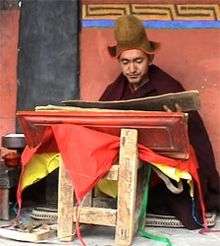
Study of major Buddhist Indian texts is central to the monastic curriculum in all four major schools of Tibetan Buddhism. Memorization of classic texts as well as other ritual texts is expected as part of traditional monastic education.[25] The main liturgical language is classical Tibetan. Another important part of higher religious education was the practice of formalized debate.
Since the late 11th century, traditional Tibetan monastic colleges generally organized the exoteric study of Buddhism into "five great textual traditions" (zhungchen-nga).[26]
- Abhidharma
- Prajnaparamita
- Madhyamaka
- Nagarjuna's Mūlamadhyamakakārikā
- Aryadeva's Four Hundred Verses (Catuhsataka)
- Candrakīrti's Madhyamakāvatāra
- Śāntarakṣita's Madhyamākalaṃkāra
- Shantideva's Bodhisattvacaryāvatāra
- Pramana
- Vinaya
- Gunaprabha's Vinayamula Sutra
Also of great importance are the "Five Treatises of Maitreya" including the influential Ratnagotravibhāga and the Mahayanasutralankara which are often attributed to Asanga and focus on Yogacara topics such as Buddha nature. Practiced focused texts such as the Yogacarabhumi and Kamalaśīla's Bhāvanākrama are the major sources for meditation. The Buddhist Tantras are another class of texts which form a whole other corpus of the Tibetan Buddhist tradition focusing on Tantra practices.
While the Indian texts are often central, newer Tibetan material is also widely studied. The commentaries and interpretations that are used to shed light on these texts differ according to tradition. The Gelug school for example, use the works of Tsongkhapa, while other schools may use the more recent work of Rimé movement scholars like Jamgon Kongtrul and Jamgon Ju Mipham Gyatso.
A corpus of extra-canonical scripture, the treasure texts (terma) literature is acknowledged by Nyingma practitioners, but the bulk of the canon that is not commentary was translated from Indian sources. True to its roots in the Pāla system of North India, however, Tibetan Buddhism carries on a tradition of eclectic accumulation and systematisation of diverse Buddhist elements, and pursues their synthesis. Prominent among these achievements have been the Stages of the Path and mind training, both stemming from teachings by the Indian pandit, Atiśa.
Transmission and realization
There is a long history of oral transmission of teachings in Tibetan Buddhism. Oral transmissions by lineage holders traditionally can take place in small groups or mass gatherings of listeners and may last for seconds (in the case of a mantra, for example) or months (as in the case of a section of the Tibetan Buddhist canon). It is held that a transmission can even occur without actually hearing, as in Asanga's visions of Maitreya.
An emphasis on oral transmission as more important than the printed word derives from the earliest period of Indian Buddhism, when it allowed teachings to be kept from those who should not hear them.[27] Hearing a teaching (transmission) readies the hearer for realization based on it. The person from whom one hears the teaching should have heard it as one link in a succession of listeners going back to the original speaker: the Buddha in the case of a sutra or the author in the case of a book. Then the hearing constitutes an authentic lineage of transmission. Authenticity of the oral lineage is a prerequisite for realization, hence the importance of lineages.
Practices
.jpg)
Rites and rituals
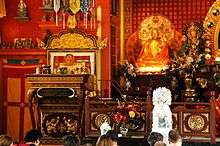
There has been a "close association" between the religious and the secular, the spiritual and the temporal[28] in Tibet. The term for this relationship is chos srid zung 'brel. Traditionally Tibetan lamas have tended to the lay populace by helping them with issues such as protection and prosperity. Common traditions have been the various rites and rituals for mundane ends, such as purifying one's karma, avoiding harm from demonic forces and enemies, and promoting a successful harvest.[29] Divination and exorcism are examples of practices a lama might use for this.[30]
Ritual is generally more elaborate than in other forms of Buddhism, with complex altar arrangements and works of art, many ritual objects, hand gestures (mudra), chants, and musical instruments.[20]
A special kind of ritual called an initiation or empowerment (Sanskrit: Abhiseka, Tibetan: Wangkur) is central to Tantric practice. These rituals consecrate a practitioner into a particular Tantric practice associated with individual mandalas of deities and mantras. Without having gone through initiation, one is generally not allowed to practice the higher Tantras.[31]
Another important ritual occasion in Tibetan Buddhism is that of mortuary rituals which are supposed to assure that one has a positive rebirth and a good spiritual path in the future.[32] Of central importance to Tibetan Buddhist Ars moriendi is the idea of the Bardo (Sanskrit: antarābhava), the intermediate or liminal state between life and death.[32] Rituals and the readings of texts such as the Bardo Thodol are done to ensure that the dying person can navigate this intermediate state skillfully. Cremation and sky burial are traditionally the main funeral rites used to dispose of the body.[33]
Preliminary practices and approach to Vajrayāna
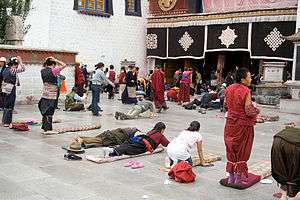
Vajrayāna is believed by Tibetan Buddhists to be the fastest method for attaining Buddhahood but for unqualified practitioners it can be dangerous.[34] To engage in it one must receive an appropriate initiation (also known as an "empowerment") from a lama who is fully qualified to give it. From the time one has resolved to accept such an initiation, the utmost sustained effort in guru devotion is essential.
The aim of preliminary practices (ngöndro) is to start the student on the correct path for such higher teachings.[35] Just as Sutrayāna preceded Vajrayāna historically in India, so sutra practices constitute those that are preliminary to tantric ones. Preliminary practices include all Sutrayāna activities that yield merit like hearing teachings, prostrations, offerings, prayers and acts of kindness and compassion, but chief among the preliminary practices are realizations through meditation on the three principle stages of the path: renunciation, the altruistic bodhicitta wish to attain enlightenment and the wisdom realizing emptiness. For a person without the basis of these three in particular to practice Vajrayāna can be like a small child trying to ride an unbroken horse.[36]
While the practices of Vajrayāna are not known in Sutrayāna, all Sutrayāna practices are common to Vajrayāna. Without training in the preliminary practices, the ubiquity of allusions to them in Vajrayāna is meaningless and even successful Vajrayāna initiation becomes impossible.
The merit acquired in the preliminary practices facilitates progress in Vajrayāna. While many Buddhists may spend a lifetime exclusively on sutra practices, however, an amalgam of the two to some degree is common. For example, in order to train in calm abiding, one might use a tantric visualisation as the meditation object.
Samatha and Vipaśyanā
Traditionally, Tibetan Buddhism follows the two main approaches to meditation as taught in all forms of Buddhism, śamatha (Tib. Shine) and vipaśyanā (Tib. lhaktong).
The practice of śamatha (calm abiding) is one of focusing one's mind on a single object such as a Buddha figure or the breath. Through repeated practice one's mind gradually becomes more stable, calm and happy. The nine stages of training the mind is the main progressive framework used for śamatha in Tibetan Buddhism.
The other form of Buddhist meditation is vipaśyanā (clear seeing, insight). This is generally seen as having two aspects, one of which is analytic meditation, thinking rationally about ideas and concepts in a scholarly or philosophical manner. As part of this process, entertaining doubts and engaging in internal debate over them is encouraged in some traditions.[37] The other type of vipaśyanā is a non-analytical, "simple" yogic style called trömeh in Tibetan, which means "without complication".[38]
A meditation routine may involve alternating sessions of vipaśyanā to achieve deeper levels of realization, and samatha to consolidate them.[8]
Guru yoga
As in other Buddhist traditions, an attitude of reverence for the teacher, or guru, is also highly prized.[39] At the beginning of a public teaching, a lama will do prostrations to the throne on which he will teach due to its symbolism, or to an image of the Buddha behind that throne, then students will do prostrations to the lama after he is seated. Merit accrues when one's interactions with the teacher are imbued with such reverence in the form of guru devotion, a code of practices governing them that derives from Indian sources.[40] By such things as avoiding disturbance to the peace of mind of one's teacher, and wholeheartedly following his prescriptions, much merit accrues and this can significantly help improve one's practice.
There is a general sense in which any Tibetan Buddhist teacher is called a lama. A student may have taken teachings from many authorities and revere them all as lamas in this general sense. However, he will typically have one held in special esteem as his own root guru and is encouraged to view the other teachers who are less dear to him, however more exalted their status, as embodied in and subsumed by the root guru.[41] One particular feature of the Tantric view of teacher student relationship is that in Tibetan Buddhist Tantra, one is instructed to regard one's guru as an awakened Buddha.[42]
Esotericism
In Vajrayāna particularly, Tibetan Buddhists subscribe to a voluntary code of self-censorship, whereby the uninitiated do not seek and are not provided with information about it. This self-censorship may be applied more or less strictly depending on circumstances such as the material involved. A depiction of a mandala may be less public than that of a deity. That of a higher tantric deity may be less public than that of a lower. The degree to which information on Vajrayāna is now public in western languages is controversial among Tibetan Buddhists.
Buddhism has always had a taste for esotericism since its earliest period in India.[43] Tibetans today maintain greater or lesser degrees of confidentiality also with information on the vinaya and emptiness specifically. In Buddhist teachings generally, too, there is caution about revealing information to people who may be unready for it.
Mantra
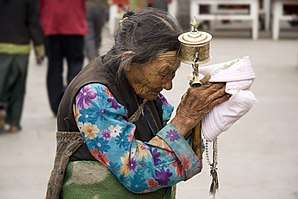
The use of (mainly Sanskrit) prayer formulas, incantations or phrases called mantras (Tibetan: sngags) is another widespread feature of Tibetan Buddhist practice.[42] So common is the use of mantras that Vajrayana is also sometimes called "Mantrayana" (the mantra vehicle). Mantras are widely recited, chanted, written or inscribed, and visualized as part of different forms of meditation. Each mantra has symbolic meaning and will often have a connection to a particular Buddha or Bodhisattva.[44] Each deity's mantra is seen as symbolizing the function, speech and power of the deity.[45] Tibetan Buddhist practitioners repeat mantras in order to train the mind, and transform their thoughts in line with the divine qualities of the mantra's deity and special power.[46]
Tibetan Buddhists see the etymology of the term mantra as meaning "mind protector", and mantras is seen as a way to guard the mind against negativity.[47] According to Lama Zopa Rinpoche:
Mantras are effective because they help keep your mind quiet and peaceful, automatically integrating it into one-pointedness. They make your mind receptive to very subtle vibrations and thereby heighten your perception. Their recitation eradicates gross negativities and the true nature of things can then be reflected in your mind’s resulting clarity. By practising a transcendental mantra, you can in fact purify all the defiled energy of your body, speech, and mind.[48]
Mantras also serve to focus the mind as a samatha (calming) practice as well as a way to transform the mind through the symbolic meaning of the mantra. In Buddhism, it is important to have the proper intention, focus and faith when practicing mantras, if one does not, they will not work. Unlike in Hinduism, mantras are not believed to have inherent power of their own, and thus without the proper faith, intention and mental focus, they are just mere sounds.[49] Thus according to the Tibetan philosopher Jamgon Ju Mipham:
if a mantra is thought to be something ordinary and not seen for what it is, it will not be able to perform its intended function. Mantras are like non-conceptual wish-fulfilling jewels. Infusing one's being with the blessings of mantra, like the form of a moon reflected on a body of water, necessitates the presence of faith and other conditions that set the stage for the spiritual attainments of mantra. Just as the moon's reflection cannot appear without water, mantras cannot function without the presence of faith and other such factors in one's being.[50]
Mantras are part of the highest tantric practices in Tibetan Buddhism, such as Deity Yoga and are recited and visualized during tantric sadhanas. Thus, Tsongkhapa says that mantra "protects the mind from ordinary appearances and conceptions".[51] This is because in Tibetan Buddhist Tantric praxis, one must develop a sense that everything is divine (divine pride).
Tantric Yoga
In what is called higher yoga tantra the emphasis is on various yoga practices which allow the practitioner to realize the true nature of reality.[22]
Deity Yoga (Tibetan: lha'i rnal 'byor; Sanskrit: Devata-yoga) is the fundamental, defining practice of Vajrayana Buddhism involving visualization of mental images. According to the Tibetan scholar Tsongkhapa, deity yoga is what separates Buddhist Tantra practice from the practice of other Buddhist schools.[52]
Deity yoga involves two stages, the generation stage and the completion stage. In the generation stage, one dissolves the mundane world and visualizes one's chosen deity (yidam), its mandala and companion deities, resulting in identification with this divine reality.[53] In the completion stage, one dissolves the visualization of and identification with the yidam in the realization of sunyata or emptiness. Completion stage practices can also include subtle body energy practices,[54] as well as other practices such as the Six Yogas of Naropa.
The views and practices associated with Dzogchen and Mahamudra are often seen as the culmination of the tantric path.[55] These practices focus on the very nature of reality and experience, termed dharmakaya.
Women in Tibetan Buddhism
Under the Mulasarvastivadin Vinaya, as with the two other extant Vinaya lineages today (Theravada and Dharmaguptaka), in order to ordain bhikṣuṇīs, there must be quorums of both bhikṣuṇīs and bhikṣus; without both, a woman cannot be ordained as a nun (Tibetan: དགེ་སློང་མ་, THL: gélongma ). When Buddhism traveled from India to Tibet, apparently the quorum of bhikṣuṇīs required for bestowing full ordination never reached Tibet.[56]
Despite an absence of ordination there, bhikṣuṇīs did travel to Tibet. A notable example was the Sri Lankan nun Candramāla, whose work with Śrījñāna (Wylie: dpal ye shes ) resulted in the tantric text Śrīcandramāla Tantrarāja (Tibetan: དཔལ་ཟླ་བའི་ཕྲེང་བའི་རྒྱུད་ཀྱི་རྒྱལ་པོ , Chinese: 吉祥月鬘本續王).[57]
There are singular accounts of fully ordained Tibetan women, such as the Samding Dorje Phagmo (1422-1455), who was once ranked the highest female master in Tibet, but very little is known about the exact circumstances of their ordination.[58]
Buddhist author Michaela Haas notes that Tibetan Buddhism is undergoing a sea change in the West. "Of all these changes that we are watching Buddhism undergo in the West, the most momentous may be that women are playing an equal role."[59] The Dalai Lama has authorized followers of the Tibetan tradition to be ordained as nuns in traditions that have such ordination. According to Thubten Chodron, the current Dalai Lama has said on this issue:[60]
- In 2005, the Dalai Lama repeatedly spoke about the bhikṣuṇī ordination in public gatherings. In Dharamsala, he encouraged, "We need to bring this to a conclusion. We Tibetans alone can't decide this. Rather, it should be decided in collaboration with Buddhists from all over the world. Speaking in general terms, were the Buddha to come to this 21st century world, I feel that most likely, seeing the actual situation in the world now, he might change the rules somewhat...."
- Later, in Zürich during a 2005 conference of Tibetan Buddhist Centers, he said, "Now I think the time has come; we should start a working group or committee" to meet with monks from other Buddhist traditions. Looking at the German bhikṣuṇī Jampa Tsedroen, he instructed, "I prefer that Western Buddhist nuns carry out this work… Go to different places for further research and discuss with senior monks (from various Buddhist countries). I think, first, senior bhikshunis need to correct the monks' way of thinking.
- "This is the 21st century. Everywhere we are talking about equality….Basically Buddhism needs equality. There are some really minor things to remember as a Buddhist--a bhikshu always goes first, then a bhikshuni….The key thing is the restoration of the bhikshuni vow."
Alexander Berzin referred to the Dalai Lama having said on occasion of the 2007 Hamburg congress:
Sometimes in religion there has been an emphasis on male importance. In Buddhism, however, the highest vows, namely the bhikshu and bhikshuni ones, are equal and entail the same rights. This is the case despite the fact that in some ritual areas, due to social custom, bhikshus go first. But Buddha gave the basic rights equally to both sangha groups. There is no point in discussing whether or not to revive the bhikshuni ordination; the question is merely how to do so properly within the context of the Vinaya.[61]
Freda Bedi (sometimes spelled Frida Bedi, also named Sister Palmo, or Gelongma Karma Kechog Palmo) was a British woman who was the first Western woman to take ordination in Tibetan Buddhism, which occurred in 1966.[62]
Pema Chödrön is an American woman who was ordained as a bhikṣuṇī in a lineage of Tibetan Buddhism in 1981. Pema Chödrön was the first American woman to be ordained as a Buddhist nun in the Tibetan Buddhist tradition.[63][64]
In 2010 the first Tibetan Buddhist nunnery in America, Vajra Dakini Nunnery in Vermont, was officially consecrated. It offers novice ordination and follows the Drikung Kagyu lineage of Buddhism. The abbot of the Vajra Dakini nunnery is Khenmo Drolma, an American woman, who is the first bhikṣuṇī in the Drikung lineage of Buddhism, having been ordained in Taiwan in 2002.[65][66] She is also the first westerner, male or female, to be installed as an abbot in the Drikung Kagyu lineage of Buddhism, having been installed as the abbot of the Vajra Dakini Nunnery in 2004.[65] The Vajra Dakini Nunnery does not follow The Eight Garudhammas.[67]
In April 2011, the Institute for Buddhist Dialectical Studies (IBD) in Dharamsala, India, conferred the degree of geshe, a Tibetan Buddhist academic degree for monastics, on Kelsang Wangmo, a German nun, thus making her the world's first female geshe.[68][69] In 2013 Tibetan women were able to take the geshe exams for the first time.[70] In 2016 twenty Tibetan Buddhist nuns became the first Tibetan women to earn geshe degrees.[71][72]
Jetsunma Ahkon Lhamo gained international attention in the late 1980s as the first Western woman to be a His Holininess Penor Rinpoche enthroned tulku within the Nyingma Palyul.[73]
History
Tibetan Empire - first dissemination (7th-9th century)
Buddhism was formally introduced into Tibet during the Tibetan Empire (7th-9th century CE). Sanskrit Buddhist scriptures from India were first translated into Tibetan under the reign of the Tibetan king Songtsän Gampo (618-649),[74] In the 8th century King Trisong Detsen (755-797) established it as the official religion of the state.[75] Trisong Detsen invited Indian Buddhist scholars to his court, including Padmasambhāva (8th century) and Śāntarakṣita (725–788)), who founded the Nyingma, The Ancient Ones, the oldest school of Tibetan Buddhism.[76] There was also influence from the Sarvāstivādins from Kashmir to the southwest[77] and Khotan to the northwest.[78] Trisong Detsen also invited the Chan master Moheyan[note 2] to transmit the Dharma at Samye Monastery. According to Tibetan sources, Moheyan lost the socalled council of Lhasa (793), a debate sponsored by Trisong Detsen on the nature of emptiness with the Indian master Kamalaśīla, and the king declared Kamalaśīlas philosophy should form the basis for Tibetan Buddhism.[79][80][note 3][note 4]
Era of fragmentation (9th-10th century)
A reversal in Buddhist influence began under King Langdarma (r. 836-842), and his death was followed by the socalled Era of Fragmentation, a period of Tibetan history in the 9th and 10th centuries. During this era, the political centralization of the earlier Tibetan Empire collapsed.[83]
Tibetan Renaissance - second dissemination (10th-12th century)
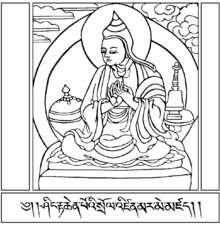
The late 10th and 11th century saw a revival of Buddhism in Tibet. Coinciding with the early discoveries of "hidden treasures" (terma),[84] the 11th century saw a revival of Buddhist influence originating in the far east and far west of Tibet.[85] In the west, Rinchen Zangpo (958-1055) was active as a translator and founded temples and monasteries. Prominent scholars and teachers were again invited from India.
In 1042 Atiśa (982-1054 CE) arrived in Tibet at the invitation of a west Tibetan king. This renowned exponent of the Pāla form of Buddhism from the Indian university of Vikramashila later moved to central Tibet. There his chief disciple, Dromtonpa founded the Kadampa school of Tibetan Buddhism, under whose influence the New Translation schools of today evolved.
The Sakya, the Grey Earth school, was founded by Khön Könchok Gyelpo (Wylie: 'khon dkon mchog rgyal po , 1034–1102), a disciple of the great Lotsawa, Drogmi Shākya (Wylie: brog mi lo tsā wa ye shes ). It is headed by the Sakya Trizin, traces its lineage to the mahasiddha Virūpa,[76] and represents the scholarly tradition. A renowned exponent, Sakya Pandita (1182–1251CE), was the great-grandson of Khön Könchok Gyelpo.
Other seminal Indian teachers were Tilopa (988–1069) and his student Naropa (probably died ca. 1040 CE).The Kagyu, the Lineage of the (Buddha's) Word, is an oral tradition which is very much concerned with the experiential dimension of meditation. Its most famous exponent was Milarepa, an 11th-century mystic. It contains one major and one minor subsect. The first, the Dagpo Kagyu, encompasses those Kagyu schools that trace back to the Indian master Naropa via Marpa Lotsawa, Milarepa and Gampopa[76]
Mongol dominance (13th-14th century)
Tibetan Buddhism exerted a strong influence from the 11th century CE among the peoples of Inner Asia, especially the Mongols. The Mongols invaded Tibet in 1240[86][87] and 1244.[88] The Mongols had annexed Amdo and Kham to the east. Sakya Paṇḍita was appointed Viceroy of Central Tibet by the Mongol court in 1249.[89]
Tibet was incorporated into the Mongol Empire, retaining nominal power over religious and regional political affairs, while the Mongols managed a structural and administrative[90][91] rule over the region, reinforced by the rare military intervention. Tibetan Buddhism was adopted as the de facto state religion by the Mongol Yuan dynasty (1271–1368), founded by Kublai Khan, whose capital is Xanadu (Beijing, China).[92]
Tibetan autonomy (14th-18th century)
With the decline of the Yuan dynansty and the loose administration of the following (Han-Chinese) Ming dynasty, Central Tibet was ruled by successive local families from the 14th to the 17th century, and Tibet would gain de facto a high autonomy after the 14th century.[93]
Family rule and establishment of Gelugpa school (14th-17th century)
Jangchub Gyaltsän (Byang chub rgyal mtshan, 1302–1364) became the strongest political family in the mid 14th century.[94] During this period the reformist scholar Je Tsongkhapa (1357–1419) founded the Gelug sect which would have a decisive influence on Tibet's history. Internal strife within the Phagmodrupa dynasty, and the strong localism of the various fiefs and political-religious factions, led to a long series of internal conflicts. The minister family Rinpungpa, based in Tsang (West Central Tibet), dominated politics after 1435. In 1565 the Rinpungpa family was overthrown by the Tsangpa Dynasty of Shigatse which expanded its power in different directions of Tibet in the following decades and favoured the Karma Kagyu sect. They would play a pivotal role in the events which led to the rise of power of the Dalai Lama's in the 1640s.
Ganden Phodrang government (17th-18th century)
The Ganden Phodrang was the Tibetan regime that was established by the 5th Dalai Lama with the help of the Güshi Khan of the Khoshut Mongols in 1642. After the civil war in the 17th century and the Mongol intervention, the Gelugpa school dominated Tibetan Buddhism, and successive Dalai Lamas and Panchans ruled Tibet as regional governance from the mid-17th to mid-20th centuries.
Qing rule (18th-20th century)
The Qing dynasty (1644-1912) established a Chinese full rule over Tibet after a Qing expedition force defeated the Dzungars (who controlled Tibet) in 1720, and lasted until the fall of the Qing dynasty in 1912.[95] The Manchu rulers of the Qing dynasty supported Tibetan Buddhism, especially the Gelug sect, for most times of their dynasty of China.[92]
The Rimé movement was a 19th-century movement involving the Sakya, Kagyu and Nyingma schools of Tibetan Buddhism, along with some Bon scholars.[96] Having seen how the Gelug institutions pushed the other traditions into the corners of Tibet's cultural life, Jamyang Khyentse Wangpo (1820-1892) and Jamgön Kongtrül (1813-1899) compiled together the teachings of the Sakya, Kagyu and Nyingma, including many near-extinct teachings.[97] Without Khyentse and Kongtrul's collecting and printing of rare works, the suppression of Buddhism by the Communists would have been much more final.[98] The Rimé movement is responsible for a number of scriptural compilations, such as the Rinchen Terdzod and the Sheja Dzö.
Modern history - 20th-21st century
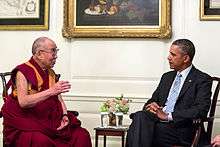
In 1912, following the fall of the Qing Dynasty, Tibet became de facto independent under the 13th Dalai Lama government based in Lhasa, maintaining the current territory of what is now called the Tibetan Autonomous Region.[100] After the Battle of Chamdo Tibet was annexed by the Chinese People's republic in 1950. In 1959 the 14th Dalai Lama and a great number of clergy fled the country, to settle in India and other neighbouring countries. The events of the Cultural Revolution (1966–76) saw religion as one of the main political targets of the Chinese Communist Party and most of the several thousand temples and monasteries in Tibet were destroyed, with many monks and lamas imprisoned.[101] Outside of Tibet however there was a renewed interest in Tibetan Buddhism in places such as Nepal and Bhutan, while the spread of Tibetan Buddhism in the Western world was accomplished by many of the refugee Tibetan Lamas who escaped Tibet.[101]
After the liberalization policies in China during the 1980s, the religion began to recover with some temples and monasteries being reconstructed.[102] Tibetan Buddhism is now an influential religion among educated Chinese and also in Taiwan.[102]
Today, Tibetan Buddhism is adhered to widely in the Tibetan Plateau, Mongolia, northern Nepal, Kalmykia (on the north-west shore of the Caspian), Siberia (Tuva and Buryatia), the Russian Far East and northeast China. It is the state religion of Bhutan.[103] The Indian regions of Sikkim and Ladakh, both formerly independent kingdoms, are also home to significant Tibetan Buddhist populations, as are the Indian states of Himachal Pradesh (which includes Dharamshala and the district of Lahaul-Spiti), West Bengal (the hill stations of Darjeeling and Kalimpong) and Arunachal Pradesh.
In the wake of the Tibetan diaspora, Tibetan Buddhism has gained adherents in the West and throughout the world. Fully ordained Tibetan Buddhist Monks now work in academia.[104]
Geoffrey Samuel sees the character of Tibetan Buddhism in the West as
...that of a national or international network, generally centred around the teachings of a single individual lama. Among the larger ones are the FPMT, which I have already mentioned, now headed by Lama Zopa and the child-reincarnation of Lama Yeshe; the New Kadampa, in origin a break-away from the FPMT; the Shambhala network, deriving from Chögyam Trungpa 's organization and now headed by his son; and the networks associated with Namkhai Norbu Rinpoche (the Dzogchen Community) and Sogyal Rinpoche (Rigpa).[105]
Glossary of terms used
| English | spoken Tibetan | Wylie Tibetan | Sanskrit transliteration |
|---|---|---|---|
| affliction | nyönmong | nyon-mongs | kleśa |
| analytic meditation | jegom | dpyad-sgom | yauktika dhyāna |
| calm abiding | shiné | zhi-gnas | śamatha |
| devotion to the guru | lama-la tenpa | bla-ma-la bsten-pa | guruparyupāsati |
| fixation meditation | joggom | 'jog-sgom | nibandhita dhyāna |
| foundational vehicle | t’ek män | theg sman | hīnayāna |
| incarnate lama | tülku | sprul-sku | nirmānakāya |
| inherent existence | rangzhingi drubpa | rang-bzhin-gyi grub-pa | svabhāvasiddha |
| mind of enlightenment | changchub sem | byang-chhub sems | bodhicitta |
| motivational training | lojong | blo-sbyong | autsukya dhyāna |
| omniscience | t’amcé k’yempa | thams-cad mkhyen-pa | sarvajña |
| preliminary practices | ngöndro | sngon-'gro | prārambhika kriyāni |
| root guru | zawé lama | rtsa-ba'i bla-ma | mūlaguru |
| stages of the path | lamrim | lam-rim | pātheya |
| transmission and realisation | lungtok | lung-rtogs | āgamādhigama |
See also
- Death horoscopes in Tibetan Buddhism
- Karma in Tibetan Buddhism
- History of Tibetan Buddhism
- Derge Parkhang
- Mahamudra
- Milarepa
- Nagarjuna
- Ngagpa
- Padmasambhava
- Pure Land Buddhism (Tibetan)
- Samaya
- Schools of Buddhism
- Shambhala Buddhism
- Songs of realization
- Tibetan art
- Tibetan prayer wheel
- Tibetan prayer flag
- Tibetan Buddhist teachers (category)
- Traditional Tibetan medicine
- Fierce deities
Notes
- ↑ Tib.: tulku, Wylie: sprul-ku
- ↑ 和尚摩訶衍; his name consists of the same Chinese characters used to transliterate “Mahayana”) (Tibetan: Hwa shang Mahayana)
- ↑ Kamalaśīla wrote the three Bhāvanākrama texts (修習次第三篇) after that.
- ↑ However, a Chinese source found in Dunhuang written by Mo-ho-yen says their side won, and some scholars conclude that the entire episode is fictitious.[81][82]
References
- ↑ White, David Gordon (ed.) (2000). Tantra in Practice. Princeton University Press. p. 21. ISBN 0-691-05779-6.
- ↑ Powers, John (2007). Introduction to Tibetan Buddhism (Rev. ed.). Ithaca, New York: Snow Lion Publications. pp. 392–3, 415. ISBN 978-1-55939-282-2.
- ↑ Cf. Dhargyey (1978), 111; Pabongkhapa Déchen Nyingpo, 533f; Tsong-kha-pa II: 48-9
- ↑ Thurman, Robert (1997). Essential Tibetan Buddhism. Castle Books: 291
- ↑ Cf. Dhargyey (1978), 64f; Dhargyey (1982), 257f, etc; Pabongkhapa Déchen Nyingpo, 364f; Tsong-kha-pa II: 183f. The former are the afflictions, negative states of mind, and the three poisons – desire, anger, and ignorance. The latter are subtle imprints, traces or "stains" of delusion that involves the imagination of inherent existence.
- ↑ Pabongkhapa Déchen Nyingpo, 152f
- ↑ Pabongkhapa Déchen Nyingpo, 243, 258
- 1 2 Hopkins (1996)
- ↑ Dhargyey (1978), 61f; Dhargyey (1982), 242-266; Pabongkhapa Déchen Nyingpo, 365
- ↑ Thurman, Robert (1997): 2-3
- ↑ Pabongkhapa Déchen Nyingpo, 252f
- ↑ Pabongkhapa Déchen Nyingpo, 367
- ↑ Dhargyey (1978), 74; Dhargyey (1982), 3, 303f; Pabongkhapa Déchen Nyingpo, 13f, 280f; Berzin, Alexander (2002). Hinayana and Mahayana: Comparison
- ↑ The Sakya school, too, has a somewhat similar textual form, the lamdré.
- ↑ Lamrim: the Gradual Path to Enlightenment
- ↑ Kapstein, Matthew T. Tibetan Buddhism: A Very Short Introduction. New York: Oxford University Press, 2014, p. 52-53.
- ↑ Powers, 2007, p. 250.
- ↑ Powers, 2007, p. 250.
- ↑ Powers, 2007, p. 250.
- 1 2 Kapstein, Matthew T. Tibetan Buddhism: A Very Short Introduction. New York: Oxford University Press, 2014, p. 82.
- ↑ Snellgrove, David. (1987) Indo-Tibetan Buddhism: Indian Buddhists and their Tibetan successors. pp 125-126.
- 1 2 Kapstein, Matthew T. Tibetan Buddhism: A Very Short Introduction. New York: Oxford University Press, 2014, p. 83.
- ↑ Conze (1993).
- ↑ Berzin, Alexander (2002). Hinayana and Mahayana: Comparison
- ↑ Kapstein, Matthew T. Tibetan Buddhism: A Very Short Introduction. New York: Oxford University Press, 2014, p. 63.
- ↑ Kapstein, Matthew T. Tibetan Buddhism: A Very Short Introduction. New York: Oxford University Press, 2014, p. 64.
- ↑ Conze (1993): 26
- ↑ Cueppers, Christoph. "The Relationship Between Religion and State (chos srid zung 'brel) In Traditional Tibet".
- ↑ Kapstein, Matthew T. Tibetan Buddhism: A Very Short Introduction. New York: Oxford University Press, 2014, p. 2.
- ↑ Kapstein, Matthew T. Tibetan Buddhism: A Very Short Introduction. New York: Oxford University Press, 2014, p. 5.
- ↑ Kapstein, Matthew T. Tibetan Buddhism: A Very Short Introduction. New York: Oxford University Press, 2014, p. 81.
- 1 2 Kapstein, Matthew T. Tibetan Buddhism: A Very Short Introduction. New York: Oxford University Press, 2014, p. 94.
- ↑ Kapstein, Matthew T. Tibetan Buddhism: A Very Short Introduction. New York: Oxford University Press, 2014, p. 100.
- ↑ Pabonka, p.649
- ↑ Kalu Rinpoche (1986), The Gem Ornament of Manifold Instructions. Snow Lion, p. 21.
- ↑ Pabongkhapa Déchen Nyingpo, 649
- ↑ khri byang blo bzang ye shes bstan ʼdzin rgya mtsho 2006, p. 66, 212f.
- ↑ The Practice of Tranquillity & Insight: A Guide to Tibetan Buddhist Meditation by Khenchen Thrangu Rinpoche. Shambhala Publications: 1994. ISBN 0-87773-943-9 pg 91-93
- ↑ Lama is the literal Tibetan translation of the Sanskrit guru. For a traditional perspective on devotion to the guru, see Tsong-ka-pa I, 77-87. For a current perspective on the guru-disciple relationship in Tibetan Buddhism, see Berzin, Alexander. Relating to a Spiritual Teacher: Building a Healthy Relationship
- ↑ notably, Gurupancasika, Tib.: Lama Ngachupa, Wylie: bla-ma lnga-bcu-pa, "Fifty Verses of Guru-Devotion" by Aśvaghoṣa
- ↑ Indian tradition (Cf. Saddharmapundarika Sutra II, 124) encourages the student to view the guru as representative of the Buddha himself.
- 1 2 Kapstein, Matthew T. Tibetan Buddhism: A Very Short Introduction. New York: Oxford University Press, 2014, p. 80.
- ↑ Cf. Conze (1993), 26 and 52f.
- ↑ Powers, John; Introduction to Tibetan Buddhism, page 23-24
- ↑ Samuel, Geoffrey. Introducing Tibetan Buddhism (World Religions), 2012, p. 74
- ↑ Powers, John; Introduction to Tibetan Buddhism, page 265
- ↑ Robert E. Buswell Jr., Donald S. Lopez Jr. The Princeton Dictionary of Buddhism
- ↑ Powers, John; Introduction to Tibetan Buddhism, page 266-67
- ↑ Powers, John; Introduction to Tibetan Buddhism, page 267
- ↑ Jamgon Mipham, Luminous Essence: A Guide to the Guhyagarbha Tantra, page 147.
- ↑ Tsoṅ-kha-pa Blo-bzaṅ-grags-pa. Tantra in Tibet: The Great Exposition of Secret Mantra, Motilal Banarsidass Publ., 1987, page 47.
- ↑ Power, John; Introduction to Tibetan Buddhism, page 271
- ↑ Garson, Nathaniel DeWitt; Penetrating the Secret Essence Tantra: Context and Philosophy in the Mahayoga System of rNying-ma Tantra, 2004, p. 52
- ↑ Garson, Nathaniel DeWitt; Penetrating the Secret Essence Tantra: Context and Philosophy in the Mahayoga System of rNying-ma Tantra, 2004, p. 45
- ↑ Kapstein, Matthew T. Tibetan Buddhism: A Very Short Introduction. New York: Oxford University Press, 2014, p. 87.
- ↑ Tsomo 1999, p. 22.
- ↑ Tsomo 1999, p. 76.
- ↑ Haas, Michaela. "Dakini Power: Twelve Extraordinary Women Shaping the Transmission of Tibetan Buddhism in the West." Shambhala Publications, 2013. ISBN 1559394072, p. 6
- ↑ "A Female Dalai Lama? Why It Matters". The Huffington Post. Retrieved May 4, 2013.
- ↑ A New Possibility: Introducing Full Ordination for Women into the Tibetan Buddhist Tradition
- ↑ Human Rights and the Status of Women in Buddhism
- ↑ "Nonfiction Book Review: The Revolutionary Life of Freda Bedi: British Feminist, Indian Nationalist, Buddhist Nun by Vicki Mackenzie. Shambhala, $16.95 trade paper (208p) ISBN978-1-61180-425-6". Publishersweekly.com. Retrieved 2017-06-10.
- ↑ "Works by Chögyam Trungpa and His Students". Dharma Haven. Dharma Haven. June 23, 1999. Retrieved 2013-10-14.
- ↑ "Ani Pema Chödrön". Gampoabbey.org. Archived from the original on 2010-11-17. Retrieved 2010-11-19.
- 1 2 "Women Making History". Vajradakininunnery.org. Archived from the original on 2010-06-01. Retrieved 2010-11-19.
- ↑ "Khenmo Drolma". Vajradakininunnery.org. Archived from the original on 2010-06-01. Retrieved 2010-11-19.
- ↑ "Vajra Dakini Nunnery". Vajra Dakini Nunnery. Retrieved 2010-11-19.
- ↑ Haas, Michaela (2011-05-18). "2,500 Years After The Buddha, Tibetan Buddhists Acknowledge Women". Huffington Post.
- ↑ "Geshe Kelsang Wangmo, An Interview with the World's First Female Geshe « Mandala Publications". Mandalamagazine.org. Archived from the original on 2013-04-15. Retrieved 2014-08-25.
- ↑ Haas, Michaela. "Buddhist nun professors or none? – OnFaith". The Washington Post.
- ↑ Nuns, Tibetan (2016-07-14). "Tibetan Buddhist Nuns Make History: Congratulations Geshema Nuns! - The Tibetan Nuns Project". Tnp.org. Retrieved 2016-10-04.
- ↑ July 15, 2016 (2016-07-15). "Twenty Tibetan Buddhist nuns are first ever to earn Geshema degrees - Lion's Roar". Lionsroar.com. Retrieved 2016-10-04.
- ↑ Stevens, William K. (1988-10-26). "U.S. Woman Is Named Reborn Buddhist Saint". New York Times. Retrieved 2008-07-26.
- ↑ Berzin, Alexander, A Survey of Tibetan History
- ↑ Beckwith, C.I.: The revolt of 755 in Tibet, in: The History of Tibet, ed. Alex McKay, Vol. 1, London 2003, p. 273-285 (discusses the political background and the motives of the ruler).
- 1 2 3 Berzin. Alexander (2000). How Did Tibetan Buddhism Develop?: StudyBuddhism.com
- ↑ Conze, 1993, 106
- ↑ Berzin, Alexander (2000). How Did Tibetan Buddhism Develop?; Berzin, Alexander (1996). The Spread of Buddhism in Asia
- ↑ 定解宝灯论新月释 Archived 2013-11-02 at the Wayback Machine.
- ↑ Yamaguchi, Zuihō (undated). The Core Elements of Indian Buddhism Introduced into Tibet: A Contrast with Japanese Buddhism. Source: Thezensite.com (accessed: October 20, 2007)
- ↑ 敦煌唐代写本顿悟大乘正理决 Archived 2013-11-01 at the Wayback Machine.
- ↑ Macmillan Encyclopedia of Buddhism (Volume One), page 70
- ↑ Shakabpa. p.173.
- ↑ Berzin, Alexander. The Four Traditions of Tibetan Buddhism: Personal Experience, History, and Comparisons
- ↑ Conze, 1993, 104ff
- ↑ Shakabpa. p.61: 'thirty thousand troops, under the command of Leje and Dorta, reached Phanpo, north of Lhasa.'
- ↑ Sanders. p. 309, his grandson Godan Khan invaded Tibet with 30000 men and destroyed several Buddhist monasteries north of Lhasa
- ↑ Buell, ibid. p.194: Shakabpa, 1967 pp.61-2.
- ↑ "How Tibet Emerged Within the Wider Chinese Power-Political Zone". Long Revolution. 2015-04-18. Retrieved 2018-03-23.
- ↑ Wylie 1990, p. 104.
- ↑ "To counterbalance the political power of the lama, Khubilai appointed civil administrators at the Sa-skya to supervise the mongol regency."
- 1 2 The Circle of Bliss: Buddhist Meditational Art, by John C. Huntington, Dina Bangdel, Robert A. F. Thurman, p48
- ↑ Rossabi 1983, p. 194
- ↑ Petech, L. Central Tibet and The Mongols. (Serie Orientale Roma 65). Rome: Instituto Italiano per il Medio ed Estremo Oriente 1990: 85–143
- ↑ Emblems of Empire: Selections from the Mactaggart Art Collection, by John E. Vollmer, Jacqueline Simcox, p154
- ↑ Lopez, Donald S. (1998). Prisoners of Shangri-La: Tibetan Buddhism and the West. Chicago: University of Chicago Press, p. 190
- ↑ Schaik, Sam van. Tibet: A History. Yale University Press 2011, page 165-9.
- ↑ Schaik, Sam van. Tibet: A History. Yale University Press 2011, page 169.
- ↑ Kapstein, Matthew T. Tibetan Buddhism: A Very Short Introduction. New York: Oxford University Press, 2014, p. 109.
- ↑ Kapstein, Matthew T. Tibetan Buddhism: A Very Short Introduction. New York: Oxford University Press, 2014, p. 100.
- 1 2 Kapstein, Matthew T. Tibetan Buddhism: A Very Short Introduction. New York: Oxford University Press, 2014, p. 108.
- 1 2 Kapstein, Matthew T. Tibetan Buddhism: A Very Short Introduction. New York: Oxford University Press, 2014, p. 110.
- ↑ The 2007 U.S. State Department report on religious freedom in Bhutan notes that "Mahayana Buddhism is the state religion..." and that the Bhutanese government supports both the Kagyu and Nyingma sects. State.gov
- ↑ Bruce A (ed). One World – Many Paths to Peace ANU E-Press 2009 (launched by the 14th Dalai Lama) http://eview.anu.edu.au/one_world/index.php (accessed 11 May 2013)
- ↑ Samuel, Geoffrey; Tantric Revisionings: New Understandings of Tibetan Buddhism and Indian Religion, page 303 - 304
Sources
- Brunnhölzl, Karl (2004), The Center of the Sunlit Sky: Madhyamaka in the Kagyu Tradition, Shambhala, ISBN 1-55939-218-5
- Coleman, Graham, ed. (1993). A Handbook of Tibetan Culture. Boston: Shambhala Publications, Inc. ISBN 1-57062-002-4.
- Conze, Edward (1993). A Short History of Buddhism (2nd ed.). Oneworld. ISBN 1-85168-066-7.
- Cornu, Philippe (2001), "Nawoord", Schijn en werkelijkheid. De twee waarheden in de vier boeddhistische leerstelsels, KunchabPublicaties
- Dhargyey, Geshe Ngawang (1978). Alexander Berzin, ed. Tibetan Tradition of Mental Development. Translated by Sharpa Tulku (3rd ed.). Dharmsala: Library of Tibetan Works and Archives. [A pithy lam-rim by a geshe appointed in 1973 by the Dalai Lama as head of the translation team at the Tibetan Library.]
- Dhargyey, Geshe Ngawang (1982). Alexander Berzin, ed. An Anthology of Well-Spoken Advice on the Graded Paths of the Mind, Vol. I. Translated by Sharpa Tulku. Dharmsala: Library of Tibetan Works and Archives. ISBN 81-86470-29-8. [The first part of a more extensive lam-rim by a geshe appointed in 1973 by the Dalai Lama as head of the translation team at the Tibetan Library. The language of this publication is very different from that of the 1978 work by the same lama due to widespread changes in choice of English terminology by the translators.]
- Hill, John E. "Notes on the Dating of Khotanese History." Indo-Iranian Journal, Vol. 13, No. 3 July 1988. To purchase this article see: . An updated version of this article is available for free download (with registration) at:
- Hookham, S.K. (1991), The Buddha within : Tathagatagarbha doctrine according to the Shentong interpretation of the Ratnagotravibhaga, Albany, NY: State University of New York Press, ISBN 978-0791403587
- Hopkins, Jeffrey (1996). Meditation on Emptiness. Boston: Wisdom. ISBN 0-86171-110-6. [Definitive treatment of emptiness according to the Prasaṅgika-Madhyamaka school.]
- Lati Rinpoche (1980). Elizabeth Napper, ed. Mind in Tibetan Buddhism: Oral Commentary on Ge-shay Jam-bel-sam-pel's "Presentation of Awareness and Knowledge Composite of All the Important Points Opener of the Eye of New Intelligence. Translated by Napper. Valois, NY: Snow Lion. ISBN 0-937938-02-5.
- Mullin, Glenn H (15 December 2008). Living in the Face of Death: The Tibetan Tradition. Snow Lion Publications. ISBN 978-1-55939-908-1.
- Nyanaponika Thera (1965). The Heart of Buddhist Meditation. Boston: Weiser. ISBN 0-87728-073-8.
- pha bong kha pa byams pa bstan ʼdzin ʼphrin las rgya mtsho; khri byang blo bzang ye shes bstan ʼdzin rgya mtsho; Michael Richards (3 November 2006). Liberation in the Palm of Your Hand: A Concise Discourse on the Path to Enlightenment. Simon and Schuster. ISBN 978-0-86171-500-8.
- Powers, John. History as Propaganda: Tibetan Exiles versus the People's Republic of China (2004) Oxford University Press. ISBN 978-0-19-517426-7
- Ringu Tulku. The Ri-Me Philosophy of Jamgon Kongtrul the Great: A Study of the Buddhist Lineages of Tibet. Shambhala. ISBN 1-59030-286-9.
- Smith, E. Gene (2001). Among Tibetan Texts: History and Literature of the Himalayan Plateau. Boston: Wisdom Publications. ISBN 0-86171-179-3
- Sopa, Geshe Lhundup; Jeffrey Hopkins (1977). Practice and Theory of Tibetan Buddhism. New Delhi: B.I. Publications. ISBN 0-09-125621-6. [Part Two of this book, ‘’Theory: Systems of Tenets’’ is an annotated translation of ‘’Precious Garland of Tenets (Grub-mtha’ rin-chhen phreng-ba)’’ by Kön-chok-jik-may-wang-po (1728-1791).]
- Tsomo, Karma Lekshe (1 April 1999). Buddhist Women Across Cultures: Realizations. State University of New York Press. ISBN 978-0-7914-4138-1.
- The Great Treatise on the Stages of the Path to Enlightenment
- Tsong-kha-pa (2000). Joshua Cutler; Guy Newland, eds. The Great Treatise on the Stages of the Path to Enlightenment, Volume I. Canada: Snow Lion. ISBN 1-55939-152-9.
- Tsong-kha-pa (2002). Joshua Cutler; Guy Newland, eds. The Great Treatise on the Stages of the Path to Enlightenment, Volume II. Canada: Snow Lion. ISBN 1-55939-168-5.
- Tsong-kha-pa (2004). Joshua Cutler; Guy Newland, eds. The Great Treatise on the Stages of the Path to Enlightenment, Volume III. Canada: Snow Lion. ISBN 1-55939-166-9.
- Wallace, B. Alan (1999), "The Buddhist Tradition of Samatha: Methods for Refining and Examining Consciousness", Journal of Consciousness Studies 6 (2-3): 175-187 .
- Yeshe De Project (1986): Ancient Tibet: Research Materials from The Yeshe De Project. Dharma Publishing, Berkeley, California. ISBN 0-89800-146-3.
Further reading
Introductory books
- John Powers (1995, 2007), Introduction to Tibetan Buddhism, Snow Lion Publications
- John Powers (2008), A Concise Introduction to Tibetan Buddhism, Snow Lion Publications
- Matthew T. Kapstein (2014), Tibetan Buddhism: A Very Short Introduction, Oxford University Press
- Wallace, B. Alan (October 25, 1993). Tibetan Buddhism From the Ground Up: A Practical Approach for Modern Life. Wisdom Publications. ISBN 0-86171-075-4, ISBN 978-0-86171-075-1
"Insider" texts
- Yeshe, Lama Thubten (2001). "The Essence of Tibetan Buddhism". Lama Yeshe Wisdom Archive. ISBN 1-891868-08-X
Other books
- Coleman, Graham, ed. (1993). A Handbook of Tibetan Culture. Boston: Shambhala Publications, Inc. ISBN 1-57062-002-4.
- Ringu Tulku. The Ri-Me Philosophy of Jamgon Kongtrul the Great: A Study of the Buddhist Lineages of Tibet. Shambhala. ISBN 1-59030-286-9.
- Smith, E. Gene (2001). Among Tibetan Texts: History and Literature of the Himalayan Plateau. Boston: Wisdom Publications. ISBN 0-86171-179-3
- Articles
- Cabezón, José Ignacio. "Tibetan Buddhist Society." In: Juergensmeyer, Mark (editor). The Oxford Handbook of Global Religions. October 2006. Published online in September 2009. DOI: 10.1093/oxfordhb/9780195137989.003.0010
External links
| Wikimedia Commons has media related to Tibetan Buddhism. |
| Wikiversity has learning resources about Buddha oracle#10 The Cosmos (Tibetan Buddhism) |
| Wikisource has the text of the 1911 Encyclopædia Britannica article Lāmāism. |
- Tibetan Buddhism at Curlie (based on DMOZ)
- Buddhist Meditation Traditions in Tibet: The Union of Three Vehicles by Georgios T. Halkias
- LamRim.com — Tibetan Buddhist Internet Radio
- The Tibetan and Himalayan Digital Library
- The Tibetan Buddhist Resource Center
- the Tibetan bibliography database
- Tibetan Buddhism in the West by Dzongsar Khyentse Rinpoche
- Songtsen — The rescue and preservation of Tibet's cultural and spiritual traditions
- Tibetan Buddhism in Study Buddhism: An extensive source of authentic Buddhist teachings, presented in a down-to-earth and practical way — formerly The Berzin Archives, a site maintained by Alexander Berzin
- Lotsawa House | Tibetan Buddhist Texts | Translations
- Tibetan Rimé Text Library — Buddhist Text Library of all traditions
- Tibetan Buddhism Forums
- A Day In The Life Of A Tibetan Monk - article and slideshow by National Geographic
- Student film about Tibetan Monks studying at Emory University
- Tibetan Buddhist Practice eCalendar
- Karma Kagyü Calendar
- Tibetan Philosophy article in the Internet Encyclopedia of Philosophy
- The History of Relationship Development Between Imperial China and Tibetan Regime in Tang and Song Dynasty

